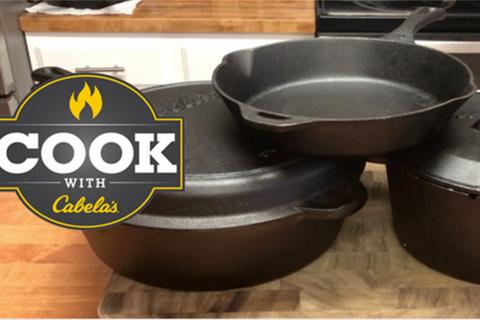
What is Seasoning Cast Iron?
Cast iron has been used in the kitchen and around the campfire for hundreds of years and for good reason. They are low cost, versatile, and as hardy as a grizzly bear. That’s why your grandma is probably using the same cast iron pan as her grandma. These things will last forever if taken care of the correct way.
One of the biggest downfalls of cast iron is that you do have to put in more effort than almost any other kind of kitchen accessory. This process is called seasoning the cast iron. No we’re not rubbing Whiskey Steak Rub (link) into the pan to give it flavor. Seasoning in this sense means coating the cast iron with oil and heating it to a point where the oil soaks into the pan. Lotion is to dry skin as oil is to cast iron. Make sense?
Tip: Shop Cabela’s 5 Piece Cast Iron Starter Set
There Are Two Ways to Season New Cast Iron
The extra work that is put into caring for cast iron is every bit worth it. After about 6 months of regular use and care, the cast iron soaks up a little bit of flavor from each meal making every meal thereafter, even better. Let’s get into it:
PRE-SEASONING
SCRUB & WASH
When you get cast iron out of the box it will likely have a factory applied coating on the surface to prevent rust. Many cast iron manufactures will tell you they are “Pre-Seasoned” and “ready to go out of the box”. This may be true, but just to be safe, there is no risk in re-seasoning cast iron and this way, you’ll know it’s 100% clean and ready to go.
Scrub all pans with steel wool and soap. The steel wool will act as a “buffer” and help smooth out the bottom and walls to help the pan become non-stick. The more you use and clean the pan, the smoother the bottom will become. You will see the water is dirty from the manufacturer's application of oil and debris coming off from scrubbing.
DRY
Cast Iron and water go together like matches and gasoline. When cast iron is exposed to water for long (or even short) periods of time, rust will start to develop. After you are done washing the pans with soap and water, dry the pans immediately. You can see in the video after only 15 minutes of the wet pan sitting to the side, it began to rust.
If you do see rust starting to form, give it a quick scrub with steel wool and water and it should come right off. Then dry it as soon as you are done washing.
OIL
The cast iron is now all clean and ready to be seasoned. Apply a coat of vegetable or canola oil all over each piece of cast iron (even the outsides and bottom). This oil is what will get baked into the cast iron and prevent it from the evil oxygen which causes rust.
Methods of Seasoning Cast Iron
OVEN METHOD (longer)
Preheat the oven to 400 degrees
Place all oiled pans upside down & place a piece of aluminum foil at the bottom of the oven. Baking the pans upside down will prevent oil from pooling in the pans which can cause damage. The foil will catch any drips coming off of the pans.
Bake for 1 hour.
Turn off the oven and allow the cast iron to cool inside the oven to room temperature.
STOVE TOP METHOD (shorter)
Place the oiled pan on your burner and turn to medium heat.
If oil pools, wipe it out with a paper towel. When oil pools for an extended period of time in a hot pan it can cause damage.
Once it starts smoking, turn the burner off.
Leave the pan on the burner until it cools to room temperature.
Post-Seasoning & Care of Cast Iron
FINAL RINSING
No matter which method you decide to go with, you’ll finish the pans with a final rinsing. We call it rinsing because we will not be using soap for this wash! If you use soap here, you’ll be removing all the seasoning you just worked to build up. Just use a NON soapy washcloth, brillo pad, or sponge and rinse that pan until the wipe of a paper towel comes out clean.
The key to keeping cast iron in the best condition is to wash the pan with only water after every use. Using soap to wash the pan will strip the cast iron of all the seasoning you worked so hard to build up. Now if you cooked something extremely greasy, a little soap will help remove the excess oil but try not to scrub too hard when using soap.
DRY
Make sure to dry ASAP! Since the seasoning is done and we didn’t use soap, the pans are at less risk to get rusty. But until the final oiling, you can never be too careful.
NOTE: If you wipe the pan with a paper towel and it comes back 95% clean you are good to go. That 5% is the seasoning you want to keep on the pan but anymore than that may need another wash.
FINAL OILING
Rub oil on the insides (just where food touches) of all the pans after the final rinsing. This serves a couple of different purposes. First, it’s the final barrier between the cast iron and the evil oxygen. If you always keep your cast iron oiled, it will never rust. Second, it actively seasons the pan after every use making it become more and more non-stick.
- 5598 views

